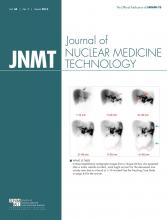Aaron T. Scott, CNMT, NMAA, FSNMMI-TS
The past several months have been busy for SNMMI-TS. As we continue to focus on advocacy efforts to ensure the continued success of the quality initiative and work to launch the membership initiative (see my September 2015 JNMT message), SNMMI-TS has taken the lead in several important areas. Below is an outline of these efforts:
On April 20, 2015, a meeting of the nuclear medicine advanced associate stakeholders was held in Chicago. Afterward, a stakeholders’ report was drafted and sent to the meeting participants for review and comment. The advanced associate council and SNMMI reviewed the report during the mid-winter meeting, and the final document is now being circulated to the participating groups with a request for formal organizational endorsement. The report will then be published in JNMT this summer.
On September 30, 2015, SNMMI-TS submitted comments to JRCNMT relating to the proposed revision of the JRCNMT standards.
On October 1, 2015, SNMMI-TS submitted comments to the ARRT nuclear medicine technology practice analysis advisory committee on the revision of “ARRT Content Specifications: The Nuclear Medicine Technology Examination” and “ARRT Primary Certification: Didactic and Clinical Competency Requirements—Nuclear Medicine Technology.” The comments included feedback from the SNMMI-TS educators’ committee, SNMMI-TS scope-of-practice task force, SNMMI-TS advocacy committee, SNMMI-TS executive board, and SNMMI board of directors.
On January 14, 2016, SNMMI-TS submitted comments on Florida’s licensure requirements for nuclear medicine technologists to perform CT scans. It is our understanding that this topic was discussed and tabled at the advisory council’s last meeting and that, consequently, nuclear medicine technology certification board (NMTCB) CT–certified technologists were not recognized under the current requirements. The SNMMI-TS comments outlined that both NMTCB and ARRT are recognized credentials within the SNMMI-TS and nuclear medicine communities.
New this year, through the international committee, we are working to develop an international exchange program. The 2-week exchange program for nuclear medicine technologist students would be focused on the United States and various countries around the world. The purpose of the program is to provide experience and training in nuclear medicine and molecular imaging modalities in the areas of cardiology, neurology, and oncology. The program is expected to advance student research and clinical expertise, as well as facilitate professional development to equip students to make significant contributions to the field of nuclear medicine. As a first step, we are reaching out to our international colleagues to determine whether there is interest and, if so, what the likelihood is that the institution or organization the individual works for would be willing to participate in the program. We hope to have at least one exchange in process by the end of the year.
Once again, the SNMMI-TS has been asked to provide 2 guest authors for an EANM technologist’s guidebook. This one, on dose optimization, is due out next year. Furthermore, the technologist committee of the European Association of Nuclear Medicine has agreed to have a joint session with SNMMI at the European congress in Barcelona, focused on the same topic as the guidebook and utilizing one of our designated authors as a speaker.
In April, I will have the opportunity to attend the annual meeting of the Australian and New Zealand Society of Nuclear Medicine (ANZSNM), to be held in Rotorua, New Zealand. This meeting will provide professional development in core nuclear medicine and present new developments in molecular imaging. The scientific program has been designed to cover the latest findings in Australasian research and to engage participants in practical workshops that have broad appeal. The invited speakers will focus on the theme “Hot Science: An Eruption of Isotopes” and the subtheme “Quantitative Nuclear Medicine: Delivering Evolving Ideas on the Science and Clinical Application of New Isotopes and Radiopharmaceuticals.” This will be my first time attending this meeting; however, SNMMI-TS has been represented for several years now. The best technologist abstract will be chosen during the meeting and will, in turn, be presented at the SNMMI annual meeting as part of the SNMMI-TS/ANZSNM abstract exchange program. The winning abstract and its author will also be recognized during the SNMMI-TS plenary and awards ceremony.
In addition, I have created an SNMMI-TS history task force. This group will be similar in scope to the SNMMI history committee and will focus on identifying and creating opportunities and programs to elevate the history of the section, as well as technologists in general. Brenda King, CNMT, FSNMMI-TS, will be serving as chair and is currently seeking additional task force members. With the annual meeting quickly approaching, we would like to get started soon.
In closing, over the past 6 months I have learned a great deal about the important interactions that the leadership and committee chairs must have on a regular basis. There are so many dedicated people who make SNMMI-TS successful, and I am pleased to be a part of this group. I am excited about the professional changes we are seeking and the standards of quality we are trying to raise. I look forward to the remaining 4 months of my presidency and to the launch of the international exchange program, the continued momentum of the quality initiative, and the findings of the membership initiative.








